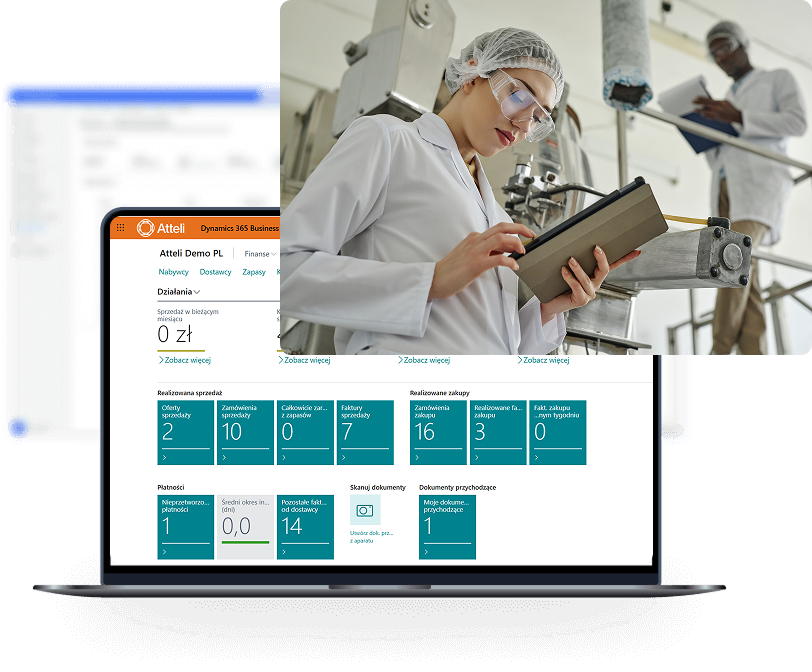Comprehensive implementation of Dynamics 365 Business Central in a large food manufacturing company
Case Study
Client
A major food producer with over 300 ERP system users, operating under both in-house and contract manufacturing models. The company conducts complex operations across Poland: from agricultural raw material processing, through production and packaging, to the export of finished goods. It manages several large facilities, including a headquarters, a processing plant, and warehouses for both raw materials and finished products.
Products are distributed both in Poland and abroad, including the United States, where specific customs and quality regulations apply.
Challenges before implementation
The company had been using a proprietary IT system along with numerous external tools and Excel spreadsheets.
Key issues included:
- Lack of process integration: 80% of operational activities were carried out outside the main system
- Low level of automation: production, quality control, and warehouse processes were manual or only partially automated
- Outdated data: no real-time information on inventory levels, batch status, or production costs
- Complex planning: production was not driven by orders but by the natural growth cycle of raw materials, requiring a completely different planning approach
- Reporting difficulties: data for analysis was processed in Excel, which was time-consuming and prone to errors
Project goals and scope
- Implement an integrated ERP system (Dynamics 365 Business Central) covering finance, production, logistics, quality, sales, and purchasing
- Consolidate dispersed data and processes into a single platform
- Develop a dedicated mobile application to support activities on the production floor and in the warehouse
- Enable real-time planning and monitoring of the entire supply chain — from raw materials to export sales

Functional scope and solutions

1. Finance and controlling
Full accounting support: costs tracked by both account types and departments, VAT settlement, advanced warehouse posting setup, extensive dimension sets, reporting, and receivables analysis.
The cost accounting model for production was developed in collaboration with the client’s team and includes full allocation of both direct and indirect costs (e.g. raw materials, wages, logistics).
Month-end closing includes precise reconciliation of production variances.
Integration with Power BI – daily updated operational and financial reports based on data from the Business Central API.

2.Production and planning
A non-standard production planning model – production depends on the availability of raw materials, which grow independently of market orders.
Management of raw material classes – different quality grades impact downstream processes (e.g. freezing, packaging, preserving).
Multi-level MPS/MRP planning – takes into account equipment constraints (production lines, maintenance) and specific requirements (e.g. kosher production).
Integration with external systems (APS) – including visual planning using Gantt charts.

3. Logistics and warehouse management
Handling of bulk materials (e.g. straw) – difficult to weigh precisely and stored loosely in fields.
Integration with industrial scales and delivery monitoring cameras – deliveries are registered via license plates and automatically documented in the system.
Dedicated mobile application (custom solution): supports production, quality control, and logistics through data collectors. Features include batch and pallet barcode scanning, material transfers between warehouses, and batch status handling (e.g. “released for production”).
Support for RR invoices for purchases from flat-rate farmers – automated generation of purchase documents on the client side.

4. Quality and batch traceability
Full batch traceability – each batch is clearly linked to the testing process, with the ability to track it across multiple deliveries and production stages.
Batch quality statuses – only batches with the appropriate status can be used in production or sales.
Complete traceability – ability to trace back to a specific delivery in the event of a complaint or the need to recall a product from the market.
Compliance with the HACCP quality system – aimed at preventing and minimizing the risk of food contamination.

5. Sales and export
Adaptation of sales processes for international markets (including the US and EU), covering aspects such as customs duties (e.g. anti-dumping duties, export fees), and adjusting packaging and shelf life to meet retail chain requirements (e.g. at least 75% of shelf life remaining).
Integration with logistics partners and transport management systems.
Implementation outcomes
- Document processing time for outbound shipments reduced from 30 minutes to 30 seconds
- Full automation of warehouse and production documents
- Reduction in operational errors (e.g. releasing unapproved batches)
- Real-time visibility into inventory levels, including batch segmentation by status (e.g. disqualified, quarantine)
- Enabled flexible production and sales planning despite variable quality and quantity of raw materials, with balanced use of the main component due to its short shelf life
- Improved reporting and financial planning – full cost control
- Greater data transparency for operations, logistics, finance, and management teams


Why this project was unique
The key challenge was a highly unusual production planning model based not on customer orders but on raw material availability, which required a non-standard approach. Additionally, the food industry in which the client operates is governed by strict quality requirements – comparable to those in the pharmaceutical sector.
The implementation itself covered multiple sites and production facilities, with the project spanning over 1,400 man-days. The integration scope was extensive – ranging from industrial scales to mobile applications used by operational staff. From day one, the system ensured high data quality and fully automated reporting, enabling faster decision-making and improved process control.
Do you want to know more?
